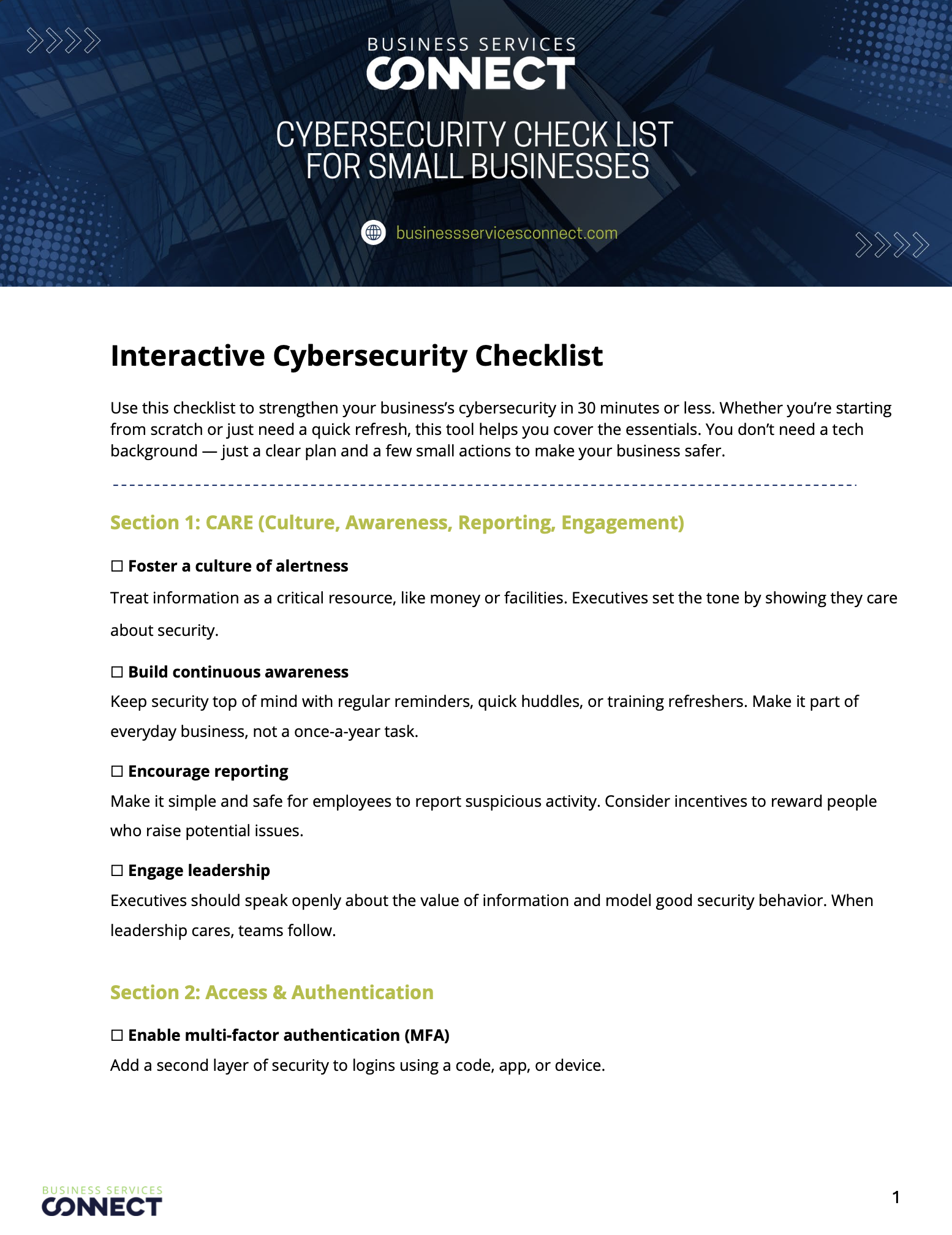New Cyber Threats Facing SMBs — And What to Do About Them
October is National Cybersecurity Awareness Month, and it’s the perfect time to check in on your business’s digital defenses to better protect your sensitive information. The cyber threat landscape isn’t what it was even a year ago. Threats are evolving quickly, and the small and mid-sized businesses (SMBs) that haven’t kept pace may be more vulnerable than they think.
Learn how today’s top cyber threats could disrupt your business, and what you can do to protect your team, data, and operations. Then, use the checklist at the end to turn these insights into action.
Find Your Business Providers
Jump to a topic:
Why Small Business Cyberattacks Are Rising
- Fewer protections: Many SMBs don’t have a dedicated IT or security team, and are less likely to have established cybersecurity measures in place.
- Valuable data: Even small companies hold sensitive customer, payment, or employee data that hackers can benefit from.
- Easier entry points: Older systems, reused passwords, and unsecured Wi-Fi networks are common gaps. Cybersecurity policies, like locking down laptops and other data endpoints, or using a password manager, are also less likely to be in place.
This combination makes SMBs both valuable and vulnerable, especially for businesses that see increased customer activity or online transactions during Q4.
Your data is more than just files — it’s one of your most valuable resources, often more critical than your annual revenue. Leaders who treat information like money, people, or facilities set the tone for the entire company. When executives show that data security matters, employees are far more likely to take cybersecurity seriously.
Top 5 Cybersecurity Threats for SMBs Right Now
Phishing and AI-Powered Scams
Phishing attacks involve using fake emails, texts, or pop-up messages to trick employees into clicking a link, opening an attachment, or entering login info. They often look like a trusted source, such as a vendor, a bank, or even someone from your own team.
Why it matters: One wrong click can install malware or give criminals access to your systems.
What to do:
- Train your team to spot red flags like typos, urgent language, or unknown links.
- Use email filters to block known threats.
- Encourage employees to double-check unusual requests.
Ransomware Attacks
This malware locks up your files or entire system until you pay a ransom, often in cryptocurrency. Even if you pay, there's no guarantee you'll regain access, and the downtime can be devastating.
Why it matters: A single infected device can halt operations, cut off access to customer data, or freeze your ability to invoice and accept payments.
What to do:
- Back up critical data regularly (and test your backups).
- Keep all software and devices updated.
- Limit admin access to only those who need it.
Find Cybersecurity Business Solution Providers
Business Email Compromise and Social Engineering Attacks
Cybercriminals impersonate executives, vendors, or partners to trick employees into transferring money or sharing sensitive data. These messages often bypass spam filters because they don’t contain links or attachments.
Why it matters: The average business email compromise (BEC) loss for SMBs can be in the tens of thousands — not including lost time and trust.
What to do:
- Enable multi-factor authentication (MFA) for all business accounts.
- Set up approval steps for financial transactions.
- Encourage a "trust but verify" approach to unusual requests.
Outdated Systems and Unpatched Software
Old operating systems, unpatched apps, and unsupported hardware are magnets for hackers and pose an enormous cybersecurity risk. These vulnerabilities are well-known and easy to exploit.
Why it matters: Legacy systems might still work day-to-day, but they often lack basic protections against modern threats and malicious software.
What to do:
- Turn on automatic updates wherever possible.
- Replace aging hardware that no longer supports security updates.
- Audit your systems quarterly to check for risk areas.
Weak or Reused Passwords
If employees reuse passwords across work and personal accounts or use simple combinations (like "password123"), attackers can gain access with little effort — especially through credential-stuffing attacks.
Why it matters: One breached password can lead to system-wide compromise.
What to do:
- Require strong, unique passwords for every login.
- Use a password manager to simplify access.
- Change passwords regularly and immediately after any known breach.
People First: Building a Culture of Cybersecurity
- Talk about security year-round. Keep it in everyday conversations, not just annual training.
- Encourage and reward reporting. Recognize employees who flag suspicious activity. Even small incentives can reinforce good behavior.
- Make accountability clear. Every business, no matter the size, needs someone responsible for security tasks.
- Provide cybersecurity resources to employees. Install firewalls and anti-malware software, and institute a cybersecurity plan that includes best practices tailored to your industry.
Cybersecurity Best Practices for Business Leaders
You don’t need a full IT department to protect your business. What you do need is focus, accountability, and a few smart actions that make the biggest impact. Start with your most critical information — customer data, financial records, and employee details — and build your protections around it.
Here are eight steps you can take this week to strengthen your defenses:
- Assign accountability for cybersecurity. Designate a staff member, team lead, or IT partner to own ongoing security tasks so nothing falls through the cracks.
- Conduct a risk assessment. You can’t protect your business if you don’t know where the cracks are. Identify your assets and look for potential vulnerabilities so you can build a risk management plan.
- Enable multi-factor authentication (MFA). Turn on MFA for all cloud tools, email accounts, and banking logins to add an extra layer of security.
- Audit and manage user access. Remove old accounts, confirm who has administrative privileges, and limit elevated privileges to only those who truly need them.
Find Cybersecurity Business Solution Providers
- Raise team awareness. Host a short team huddle on common phishing scams and how to recognize a data breach, share tips on reporting suspicious activity, and consider offering small rewards for employees who flag potential issues.
- Build an incident response plan. Create a step-by-step process for employees from incident reporting to proper notification to post-breach recovery.
- Back up critical files. Store backups in a secure, encrypted cloud service or offline location, and test recovery regularly.
- Evaluate your tools — including AI solutions. This should include all your security software, like antivirus software and malware. If you’re adopting AI-powered or cloud-based tools, ask vendors how they protect your data and verify that their practices meet your standards.
The Business Cybersecurity Checklist for Small and Medium-Sized Business Owners
- CARE: Culture, awareness, reporting, and engagement.
- Access & Authentication: Protecting logins with MFA, strong passwords, and account reviews.
- Backups & Recovery: Ensuring data is regularly backed up and recoverable.
- Updates & Patching: Keeping software, systems, and hardware current.
- Team Awareness & Training: Equipping employees to spot and report threats.
- Business Continuity & Planning: Preparing response plans and identifying support contacts.
Recommended Reading
Want a deeper dive into why information is the lifeblood of your business? Check out The Alchemy of Information Protection by Rich Owen. It explores how people, processes, and technology must work together to keep your most valuable resource — your data — safe.
Cybersecurity Awareness Month Tips for Small Businesses
Cybersecurity Awareness Month is about more than education. It’s about action. Small businesses don’t need to be perfect. The goal isn’t to eliminate risk completely — it’s to reduce the likelihood and impact of attacks while strengthening your resilience. Taking a few small steps now can prevent major disruptions later.
As a leader, you set the tone. When your team sees that cybersecurity is a business priority, they take it seriously, too. Even if you’re not the top executive, you can influence cybersecurity by raising awareness and modeling good habits.










